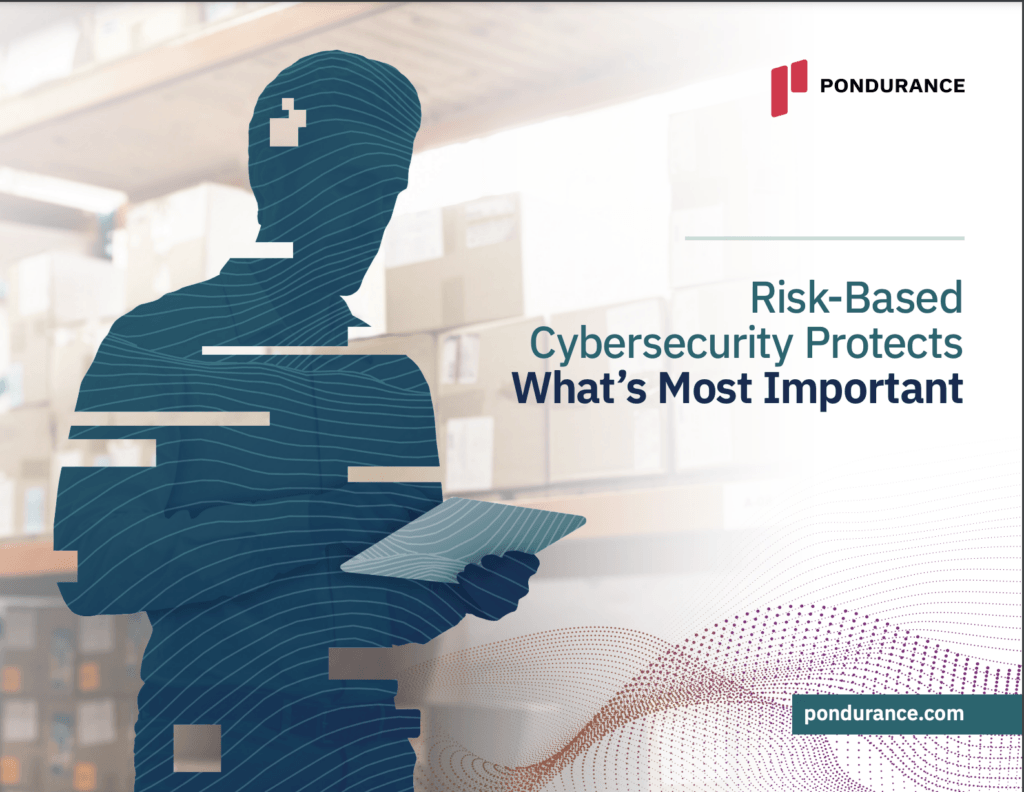Our privacy policy is located here.
Risk-Based Cybersecurity
Your cybersecurity approach should align with your company’s objectives, outcomes, and risks — making a risk-based approach to cybersecurity the best strategy for your business.
Defend What's Most Important
With a Risk-Based Cybersecurity Approach

Learn more about our risk-based approach, and dynamic defense methodology
Dustin Hutchison, Ph.D.
Protect What Matters Most with Risk-Based Cybersecurity
Pondurance — the first and only MDR provider to be built around a risk-based approach — believes a risk-based approach is the best way to protect clients from threats and reduce their exposure to attacks.

Learn more about a risk-based MDR approach
an Interview with ISMG and Doug Howard



Cyber Risk Assessment
Cyber risk assessments are vital tools used by organizations to systematically identify, assess, and mitigate potential vulnerabilities in defense of digital assets. As organizations increasingly integrate digital components into their operations, the likelihood of cyber threats and attacks also escalates, necessitating a more proactive and strategic defense approach that is where cyber risk assessments play an indispensable role.
A cyber risk assessment, a crucial part of any robust cybersecurity strategy, is essentially an audit and examination of an organization’s technological systems. It carefully scrutinizes vulnerabilities associated with its hardware, software, network connections, and digital data. It also evaluates the organization’s digital practices, policies and level of staff awareness. The primary objective is to quantify the potential impact of cyber threats to shape and inform cybersecurity measures and protocols.
Especially for small businesses, a cyber risk assessment could provide lifesaving insights on vulnerabilities and defenses. Many small enterprises assume that their size renders them unworthy targets for cyberattacks, but the reality cannot be more opposite. Cyber attackers often find smaller firms more lucrative because they have less robust defenses, making them easy access points for sensitive data. Therefore, implementing cyber risk assessments is critical in safeguarding against these threats.
A crucial aspect of a robust cyber risk assessment is compliance, as this helps an organization adhere to the required implementation standards, guidelines, and laws. A cybersecurity compliance assessment can help identify any non-compliance elements, which can be mitigated, ensuring that the organization meets all necessary regulations, thereby avoiding penalties and enhancing its cyber postures.
Another beneficial tool used in this context is the cybersecurity maturity assessment. This technique helps systematically gauge the readiness and capability of an organization to ward off cyber threats. It’s not about achieving perfection but about continuous and consistent improvement in an organization’s cybersecurity strategy.
In this context, Pondurance offers an effective and comprehensive approach in assessing your cyber risks. With a focus on a risk-based approach, Pondurance helps you manage your cybersecurity by associating your unique business context and recommending measures and controls specifically tailored for your organization. Their holistic approach includes identifying potential cyber risks, implementing proactive safeguarding methods, and enabling continuous monitoring to ensure your organization stays ahead in the cybersecurity landscape. In summary, conducting a regularly scheduled cyber risk assessment reassures that your company’s digital operations remain secure and compliant.
Conducting a Cyber Risk Assessment
Upon delving into the fascinating realm of cybersecurity, a pertinent term that finds its way to the forefront quite often is conducting a cyber risk assessment. These assessments are a crucial element in ensuring the security of organizational information systems, and they provide an extensive understanding of the potential remarks of a cyber-attack. They function as a key ingredient in the creation and implementation of robust cyber risk management programs and serve as a pathway for comprehensively evaluating the impact of potential cyber-attacks on an endeavor’s operations.
To carry out a cyber risk assessment, an organization needs to follow a methodical process that begins with the identification and categorization of assets. This categorization includes but is not limited to, hard assets such as servers and software, and soft assets; intellectual property and proprietary information. Next, the vulnerabilities associated with these assets are identified, trailed by the identification of potential threats that could exploit the vulnerabilities. Formally, this is where notable cyber risk assessment tools come into play.
These tools, designed to systematically identify, assess, and prioritize cyber risks, greatly bolster the effectiveness of the assessment. Moreover, there are numerous companies, such as Pondurance, specialized in providing these cybersecurity tools, trained to leverage innovative risk-based approaches in conducting these assessments.
The implementation of a cyber risk assessment tool can drastically streamline the process and deliver invaluable insights that promote the accurate identification and ranking of potential cyber threats, this is paramount in protecting your company’s valuable assets. The detailed reports generated by these tools can serve as a roadmap for creating and implementing effective cybersecurity strategies.
Last on our exploration into cyber risk assessments is the cyber risk assessment framework. Simply put, these frameworks provide a structured approach for managing cyber risks. They offer a set of standards, best practices, and guidelines that organizations can follow, ensuring the assessment is done in a systematic, repeatable, and continuously-improving manner. Both cyber risk assessment companies, like Pondurance, and independent organizations, can utilize these frameworks to ensure all aspects of the cybersecurity landscape are considered, and no stone is left unturned.
In sum, conducting a cyber risk assessment is a vital process for protecting an organization’s assets. Through a deliberate understanding of the significance of cybersecurity and the appropriate use of cyber risk assessment tools coupled with effective frameworks, organizations can succeed in their fight to protect their digital frontier. Pondurance, among other able companies, stands tall in their commitment to assisting organizations in their journey towards peak cybersecurity. Investing and employing these tools and frameworks can ensure a company’s cyber resilience, providing peace of mind in an increasingly digital world.
Cyber Risk Assessment Process
Understanding the nuances of cyber risk assessment is crucial in today’s increasingly digitized world. It can range from a simple evaluation of computer systems and networks to a comprehensive analysis that includes review of regulations, industry practices, and user behavior. Navigating this process can be complex, but applying cybersecurity’s risk-based approach can significantly streamline the effort.
Cyber risk assessment commences with the identification and evaluation of assets that could be affected by a cybersecurity incident. These could include hardware, systems, laptops, client data, intellectual property, and the company’s reputation. Following this, a risk profile is developed for each asset according to a predetermined scale of importance.
The second step consists of threat modeling. This comprises mapping out potential cybersecurity threats, analyzing their likelihood and impacts, and outlining the vulnerabilities that they can exploit. For example, a company may identify phishing as a high probability threat that might exploit employee ignorance as a vulnerability.
In the third stage, mitigations are identified and evaluated. These safeguards are instrumental in helping prevent, detect, or limit the impact of a threat. They might encompass antivirus software, password complexity rules, or user awareness training. For instance, in the above example, the mitigation strategy could include phishing training programs to reduce employee vulnerability.
Fourthly, the residual risks, those that remain even after the mitigation strategies are in place, are assessed. Here the company might conclude that even educated employees might still fall for sophisticated phishing attempts. Therefore, additional measures, such as software solutions that detect and quarantine phishing emails, may be necessary.
Upon completion of this risk evaluation process, a risk register or a cyber risk assessment report is developed. This document captures all the information gathered during the assessment and can serve as a useful tool for improving an organization’s cybersecurity strategy.
Implementing and managing such a robust cyber risk assessment process calls for a cybersecurity compliance risk assessment. This strategy ensures that the organization’s cybersecurity measures comply with industry regulations and standards to avoid penalties and maintain trust in the market.
Pondurance provides an example of a trusted risk-based approach to cybersecurity. Following this tactic, the emphasis is on managing, rather than eliminating all risks. This more realistic approach recognizes the impossibility of absolute security in a continually evolving cyber landscape. Pondurance thus focuses on managing prioritized risks based on potential impacts to the organization’s identified critical assets.
A risk-based approach like Pondurance’s can also save resources, as it allows companies to focus their efforts where they’re most needed. Additionally, this approach facilitates better budgeting decisions and can lead to a more resilient organization over time.
To further illustrate, consider a corporate equivalent to the cyber risk assessment process based on the risk-based approach. Firstly, a cyber risk assessment request is drafted based on a recognized need to gain insight into the company’s security posture. The request details the reasons for the assessment and the desired deliverables, highlighting the importance of the process to all stakeholders.
In conclusion, whether it’s a high-level overview or an in-depth venture, comprehensive cyber risk assessments form an integral part of managing cyber risks effectively. By being proactive and employing robust methods, like those used by Pondurance, organizations can secure themselves, their assets, and their reputation from potential cyber threats.
Informed security teams must stay vigilant against evolving cybersecurity threats and regularly conduct risk assessments to bolster their security posture and protect sensitive data from potential breaches. Top cybersecurity companies like Pondurance exemplify the importance of informed security and proactive risk management in today’s digital landscape.
Cyber Risk Assessment Companies and Services
Online security in today’s digital age is of paramount importance. A cyber risk assessment is essentially the process by which a company evaluates their exposure to data breaches and cyber attacks. Intricate and layered, these assessments probe into the exigent areas of data protection – from your IT infrastructure to the software systems in operation. Companies like Pondurance have forged new avenues in this regard with their risk-based approach, veering away from the traditional one-size-fits-all strategy by custom-tailoring each assessment to the unique needs of the client.
Cyber risk assessment services, like those provided by Pondurance and others, are essential in effectively identifying vulnerabilities, managing risk controls, and implementing robust security measures. These professional services offer far more expertise than most in-house teams can garner, thus significantly reducing exposure to cyber threats. They leverage industry-proven methodologies to provide a comprehensive understanding of the company’s risk landscape – a feat that’s invariably complex and time-consuming if executed internally.
Choosing professional cybersecurity companies and services for cyber risk assessment could spell the difference between robust online security and crippling data breaches. Benefits abound, ranging from access to a broad pool of cybersecurity expertise to cost savings in mitigating potential cyber threats early. These third-party specialists can also keep your company abreast with the constantly evolving cybersecurity landscape, ensuring that your defenses are always a step ahead. The offerings remain firm – securing business continuity, averting financial losses, and cultivating customer trust in your brand’s integrity.
Informed security teams must prioritize cyber risk management and engage with top cybersecurity companies to stay ahead of evolving cyber threats. Through rigorous threat intelligence gathering and vulnerability management, organizations can enhance their security posture and protect sensitive data from potential breaches.
